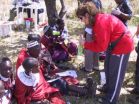(Press-News.org) PROVIDENCE, R.I. [Brown University] — In the complex genomic and molecular conspiracy that gives rise to ovarian cancer, what if researchers have been missing a whole set of suspects because they've been hiding in plain sight? That's the argument made by Brown University biologists in a new paper that combines evidence from original research and prior studies to raise new suspicions about a set of proteins that assist in regulating gene expression.
Scientists need such new leads in their investigation of ovarian cancer, the most deadly reproductive cancer. Mortality has remained tragically steady since the last major therapeutic breakthrough came in the 1990s. Pursuing the evidence that these proteins may be involved could allow researchers to make new progress.
"There is just not a lot of headway being made in ovarian cancer," said pathobiology graduate student Jennifer Ribeiro, lead author of the study online in Frontiers in Oncology. "This is a different perspective. It's a high-risk but potentially high-reward scenario."
Ribeiro's proteins of interest are called TAFs. Traditionally biologists have seen them merely as cogs in a universal and generic system that enables enzymes to transcribe genes into RNA, said study senior author Richard Freiman, associate professor of medical science at Brown. But in the new paper he and Ribeiro propose that TAFs may not merely be going about their droning business as ovarian tumors go haywire. They may be meaningfully associated with the calamity.
Guilt by many associations?
An early hint of a link between TAFs and ovarian cancer emerged in a 2011 Nature paper, coauthored by Brown University computer science researchers. Ribeiro followed up on that tip to make some of her main original findings in the new paper. By poring over the cBioPortal database of cancer genomics, she found that several TAFs are often significantly overexpressed or underexpressed in ovarian cancer. TAF2 amplifications, copy number gains, and expression increases are present in 73 percent of tumors. TAF4 is amplified or upregulated in 66 percent of tumors, and TAF4B is amplified or upregulated in 26 percent. TAF9, meanwhile, is rendered significantly less expressed in 98 percent of ovarian tumors.
The ups and downs of TAF expression alone might not be that interesting if TAF activity didn't have any mechanistic influence in cancer cell biology. But in her review of scores of studies and further original research, Ribeiro presents reasons to believe that in specific tissues and contexts around the body, these TAFs take on roles that are relevant.
"They are not just general transcription factors," Freiman said. "They do much more specific things."
The worst tumors are ones in which cells have "dedifferentiated," which means they've lost their specific identities and reverted to a more generic, stem cell-like form. Sure enough, Ribeiro and Freiman have found that TAFs such as TAF4 and TAF4B are downregulated when stem cells differentiate. That makes their upregulation in ovarian tumors suspicious.
TAF4B also emerges as a cancer suspect in the study because of its apparent role in promoting cell proliferation, a major problem in the runaway cell multiplication in tumors. Lindsay Lovasco, a postdoctoral fellow at Brown and second author of the study, ran an experiment in mouse models where she removed some of the liver and measured whether TAFs expression changed while the tissue regenerated. Expression of Taf4b (the gene in mice) did increase significantly. Also, in human ovarian granulosa cell-derived tumors, in collaboration with Dr. Barbara Vanderhyden at the University of Ottawa, Ribeiro found that TAF4B expression correlates strongly with Cyclin D2 expression, a protein that specifically promotes granulosa cell proliferation.
Even more suspicion falls on TAF4B based on Ribeiro's finding published last year in Biology of Reproduction that estrogen upregulates the protein in mouse ovaries and in estrogen-supplemented mouse ovarian tumors. In humans, long-term estrogen hormone replacement therapy has been associated with a greater risk of ovarian cancer.
Cell growth and death
Meanwhile, TAF2 may have its own cancer-related modus operandi. Work by other researchers has shown that TAF2 boosts the expression of a protein called C-SRC, that promotes cell growth and proliferation. Perhaps not surprisingly, other studies have found that C-SRC is overexpressed in ovarian tumors.
"Given these results, it is possible that TAF2 overexpression could increase transcription of C-SRC in some ovarian tumors," the researchers wrote.
But what of TAF9, which unlike its brethren seems to become notably less expressed in ovarian cancers? There, too, there is a suspicious mechanistic connection to ovarian cancer. TAF9 is a co-activator of the protein p53, which promotes cell death, a handy thing to promote in tumors. But p53 activity is also suppressed in ovarian cancer. Together, these changes may help ensure the survival of ovarian cancer cells.
Ribeiro and Freiman readily acknowledge that the case they build is circumstantial, but they argue it is more than enough for cancer researchers to look at TAFs as potential targets in their search for new treatments.
"We've compiled this hypothesis and provided the data that we think is relevant, but there still is much that is not known about it," Ribeiro said.
In the lab now, Ribeiro and Freiman are testing the effects in human ovarian cancer cells of manipulating TAF expression and function.
INFORMATION:
The American Cancer Society (grant DMC-117629) and the National Institutes of Health (grant RO1HD065445) and the Canadian Institutes of Health Research Grant (grant MOP-111194 supported the research.
Study proposes new ovarian cancer targets
2014-03-13
ELSE PRESS RELEASES FROM THIS DATE:
UCLA study yields more accurate data on thousands of years of climate change
2014-03-13
Using a cutting-edge research technique, UCLA researchers have reconstructed the temperature history of a region that plays a major role in determining climate around the world.
The findings, published online Feb. 27 in the journal Nature Geoscience, will help inform scientists about the processes influencing global warming in the western tropical Pacific Ocean.
The study analyzes how much temperatures have increased in the region near Indonesia, and how ocean temperatures affect nearby tropical glaciers in Papua New Guinea and Borneo. Researchers also evaluated ...
Migration in China: Shifting slightly, but still going strong
2014-03-13
The brain drain of educated workers is still felt most severely in China's central and western provinces, since most knowledge-based industries are generally concentrated in its large coastal cities. However, low-educated migrant workers increasingly find jobs in their home provinces in the central and western regions because of changing economic and government policy. So says Ye Liu and his colleagues of The Chinese University of Hong Kong in Hong Kong and The University of Leeds in the United Kingdom, who carried out a systematic analysis of migration trends in China ...
Mount Sinai scientists discover how Marburg virus grows in cells
2014-03-13
New York, NY – A protein that normally protects cells from environmental stresses has been shown to interact Marburg virus VP24, allowing the deadly Marburg virus to live longer and replicate better, according to a cell culture study led by scientists at the Icahn School of Medicine at Mount Sinai. The investigators say that deciphering the molecular details of how Marburg virus and the host protein interact may help in developing inhibitors of the virus. Results from the study are published online March 13 in the peer-reviewed journal Cell Reports.
Infections with Marburg ...
Commonly used pain relievers have added benefit of fighting bacterial infection
2014-03-13
Some commonly used drugs that combat aches and pains, fever, and inflammation are also thought to have the ability to kill bacteria. New research appearing online on March 13 in the Cell Press journal Chemistry & Biology reveals that these drugs, better known as NSAIDs, act on bacteria in a way that is fundamentally different from current antibiotics. The discovery could open up new strategies for fighting drug-resistant infections and "superbugs."
"We discovered that some anti-inflammatory drugs used in human and veterinary medicine have weak antibiotic activity and ...
Extinct California porpoise had a unique underbite
2014-03-13
Millions of years ago, the coast of California was home to a species of porpoise distinguished from its living relatives by a lower jaw that extended well beyond the upper, according to researchers who report their findings in the Cell Press journal Current Biology on March 13. In other words, the long-lost porpoise had a rather distinct and unusual underbite.
Careful analysis of the fossilized Semirostrum ceruttii skull also shows that the porpoise's pronounced beak included innervated jaws, which the animal likely used to feel for prey along the ocean floor.
"The ...
Humans' ability to digest milk stems from the advent of cattle domestication in Africa
2014-03-13
Most people lose the ability to digest the milk sugar lactose after weaning, but some populations retain high levels of an enzyme called lactase, which allows them to break down lactose in adulthood. In a study published March 13th in the American Journal of Human Genetics, researchers identified genetic factors associated with lactase persistence in African populations and found that this trait became more prevalent in recent history in conjunction with the introduction and spread of cattle domestication in Africa. The findings provide strong evidence that lactase persistence ...
A versatile mouse that can teach us about many diseases and drugs
2014-03-13
Scientists from the UK and Australia have created a mouse that expresses a fluorescing 'biosensor' in every cell of its body, allowing diseased cells and drugs to be tracked and evaluated in real time and in three dimensions.
This biosensor mimics the action of a target molecule, in this case a protein known as 'Rac', which drives cell movement in many types of cancer. Rac behaves like a switch, oscillating on the molecular level between two states – active or inactive.
When Rac is active, the biosensor picks up chemical cues and glows blue. When Rac is inactive the ...
Penn team links Africans' ability to digest milk to spread of cattle raising
2014-03-13
Babies are born with the ability to digest lactose, the sugar found in milk, but most humans lose this ability after infancy because of declining levels of the lactose-digesting enzyme lactase. People who maintain high levels of lactase reap the nutritive benefits of milk, however, offering a potential evolutionary advantage to lactase persistence, or what is commonly known as lactose tolerance.
A new study led by University of Pennsylvania researchers — constituting the largest investigation ever of lactase persistence in geographically diverse populations of Africans ...
Columbia researchers discover reversible mechanism that increases muscle elasticity
2014-03-13
NEW YORK, NY – How does yoga improve your flexibility? In the Mar 13 cover story of Cell, Columbia University biological sciences professor Julio Fernandez and team report the discovery of a new form of mechanical memory that adjusts the elasticity of muscles to their history of stretching. Using highly sensitive atomic force microscopes, the researchers detected a chemical reaction that increases the elasticity of muscle proteins. Crucially, this reaction targets molecules that have been exposed to a stretching force. This finding changes our understanding of how muscles ...
Researchers identify gene that helps fruit flies go to sleep
2014-03-13
In a series of experiments sparked by fruit flies that couldn't sleep, Johns Hopkins researchers say they have identified a mutant gene — dubbed "Wide Awake" — that sabotages how the biological clock sets the timing for sleep. The finding also led them to the protein made by a normal copy of the gene that promotes sleep early in the night and properly regulates sleep cycles.
Because genes and the proteins they code for are often highly conserved across species, the researchers suspect their discoveries — boosted by preliminary studies in mice — could lead to new treatments ...




